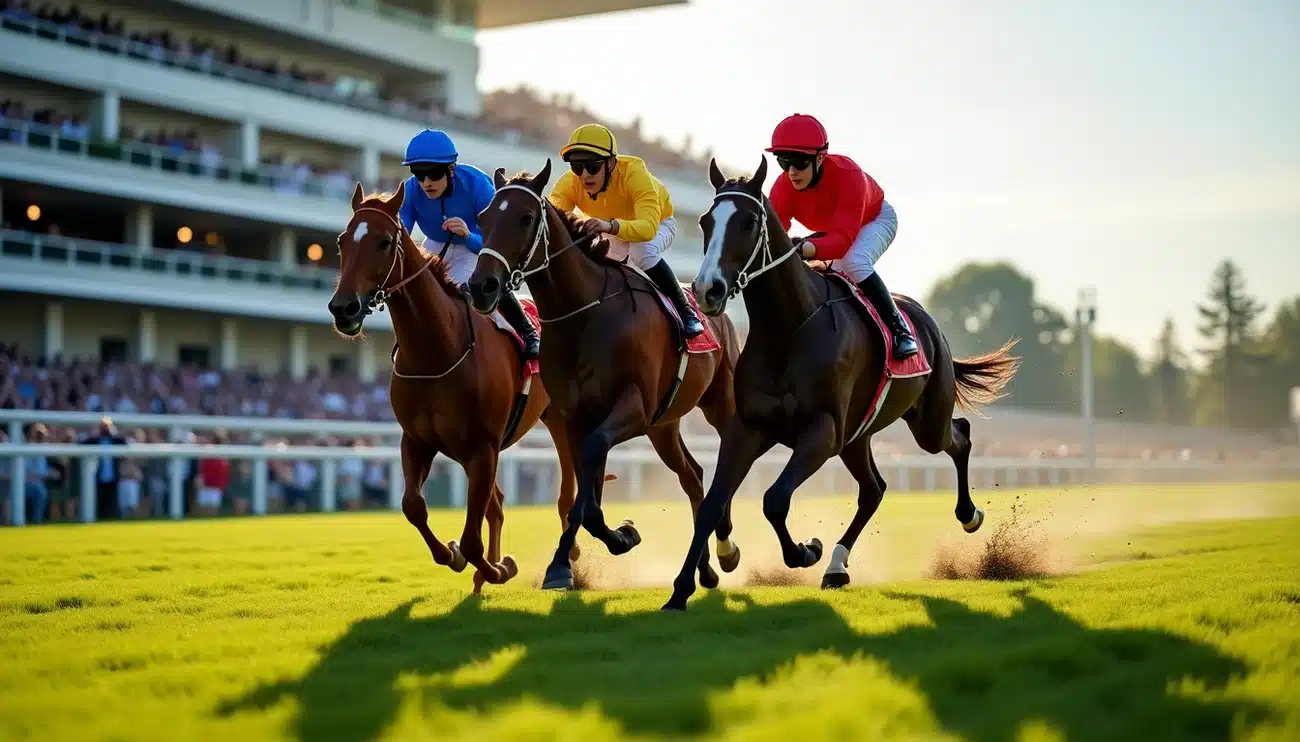Horse In Play Trading seems complicated, but you might be surprised to learn that just over 1 in 6 horses (17.8%) trade at odds-on during a race. Horse in-play trading stands out as one of the most thrilling yet challenging parts of betting. It offers high volatility and great rewards once you become skilled at it.
In-play betting on horse racing might seem daunting initially, but the right strategies make winning easier. My years of experience with Betfair in-play horse racing have taught me valuable lessons. Tracks like Ffos Las and Brighton consistently yield higher percentages of odds-on runners during races. The “Back-to-Lay” strategy can secure profits, whatever the outcome – every bettor’s dream scenario.
I’ll share proven horse racing trading strategies that I learned from professional bettors. You’ll learn how to analyse historical data through the Timeform database and understand why approximately 60% of horses that trade at odds-on win their races. These insights will help you direct your way through this ever-changing betting world more effectively, whether you’re starting or improving your current approach.
What is in-play trading in horse racing?
Trading horses during a race lets you profit from price movements without picking the winner. Horse in play trading is about making money from odds changes while the race runs, not just guessing who’ll win.
How in-play betting works
The pre-race market transforms into an in-play market the moment horses break from the gates. You can make money with a simple strategy: back high, lay low. This means betting on a horse at higher odds and laying it later at lower odds as its chances improve.
Let me give you an example. I could back a horse at 5.0 (4/1) for £10 and lay it at 2.5 (6/4) for £20 later. This gives me a £10 profit no matter what happens. Another way would be to lay a horse at low odds before the race starts and back it at higher odds if it starts running poorly.
Horse racing in-play betting can be wild because of unexpected things that happen:
- Horses might refuse to race or fall at fences
- Jockeys can make mistakes during the race
- Equipment problems like saddles slipping
- Horses at the back suddenly sprint forward
Why traders prefer Betfair Exchange
Professional bettors love using Betfair Exchange to trade horses in-play and with good reason too:
- Liquidity: Betfair leads the betting exchange market and offers the best liquidity.
- Flexibility: You can back or lay horses on the platform to profit from whatever the result.
- Technical tools: Betfair’s “Keep” option helps traders a lot. It keeps unmatched bets active after the race starts.
The exchange works like a financial market. Traders can open and close positions quickly to lock in their profits.
Key differences from pre-race betting
Betting during a race is different from pre-race betting by a lot. Prices change in milliseconds instead of minutes or hours. You need quick thinking and fast decisions.
The best part about in-play betting is seeing how horses perform before placing your bet. You can spot which horses are running smoothly, which ones struggle, and which might finish strong.
Risk levels are also different. In-play trading comes with bigger risks because markets move so fast—a horse falling at a fence can send its odds from 2.0 to 100.0 instantly. The upside is that you can make bigger profits more quickly.
TV delays can catch you off guard. Racing channels run a few seconds behind the live action. During a 5-furlong sprint, horses cover about 18 meters more than what you see on screen in just one second. The odds reflect what’s happening ahead of your TV picture, so timing matters.
Knowing these differences and planning ahead separates winners from losers in this ever-changing betting world.
Understanding the risks of in-play betting
Live horse racing trading can be thrilling, but it comes with big risks that bettors need to know about. Even seasoned traders can see their profits turn into huge losses quickly. Let me show you the main dangers of horse in play betting and how to guide you through them.
TV and live stream delays
The biggest challenge for traders at home is the broadcast delay. What you see on your screen is actually happening several seconds in the past. This creates a dangerous gap in information:
- TV broadcasts lag behind live action by 5.3 seconds
- Online streams put you 13-14 seconds behind the actual race
- Sky Racing, Racing.com, and TAB mobile apps run about 8-9 seconds behind TV broadcasts
This delay explains why markets seem to “predict” what’s about to happen on your screen. The truth is, traders at the track (or using special equipment) react to events before you see them.
Some clever operators use drones to get faster video feeds and sell access to serious in-play bettors. This practice, called “courtsiding,” happens when people at the venue send immediate information to gain an edge in betting.
Volatility and market changes
In-play horse racing markets are very volatile, especially right after a race starts. Most pros suggest waiting at least 10 seconds after the start before making any trades.
The quick odds changes happen because:
- Leading horses see their odds drop fast
- A bad start can make prices shoot up
- The favourite can become the underdog (or flip around) in seconds
This volatility brings both risk and reward. A pro trader puts it well: “Volatility is our friend! Volatility and prices reaching points they shouldn’t provide us with value to exploit as traders”.
Common mistakes new traders make
The ever-changing world of in play betting horse racing often leads new traders to make mistakes that drain their accounts:
- Chasing losses – The worst mistake is trying to recover a pre-race loss by betting in-play. The pros know this well: “I’d estimate that 17 of my 20 worst ever losses have come as a result of letting a failed trade go in running unplanned”.
- Ignoring time lags – Not accounting for broadcast delays means missing chances or betting too late.
- Betting impulsively – Random decisions without homework might feel exciting, but lead to losses.
- Neglecting race research – Good front-runner trading needs knowledge of horses’ past runs, jockey habits, and weather impact.
- Betting on high odds alone – Going after big payouts on unlikely winners usually leads to empty pockets.
These risks don’t make betfair in play horse racing impossible to profit from, but you need proper preparation. Learning these challenges helps you build effective horse racing trading strategies that work in in-play markets.
Top in-play trading strategies used by professionals
Expert traders have become skilled at specific horse in play strategies that bring consistent profits, whatever the racing market volatility. These methods need discipline and perfect timing, but reward you handsomely when done right.
Back-to-Lay: How it works and when to use it
Back-to-Lay (BTL) strategy serves as the lifeblood of profitable in play trading. You back a horse before the race at higher odds, then lay it during the race once its price drops. To cite an instance, see backing a horse at 10.0 for £10 and laying it at 5.0 for £20 – this locks in a £10 profit whatever the final result.
This strategy works best with:
- Front-runners who lead races early
- Flat racing, especially winter all-weather meets
- Handicap races (avoid maidens)
Expert traders aim to exit (lay) at around 60-65% of their back price. Some chase “DOBBING” (Double Or Bust) by laying at exactly 50% of the back price, though this needs the original odds to be at least 2.02.
Lay the Field: Best race types for this strategy
“Lay the Field” means placing lay bets on multiple runners at the same odds threshold. Math drives the profits – placing £50 lay bets on all horses in a 5-runner race at 1.5 odds means losing £25 if one horse trades at that price. You profit £25 with two matched bets, £75 with three, and £125 with four.
This approach shines in:
- Races with tight finishes where several horses might briefly trade at low odds
- Courses known for “bunched” finishes
- Longer races (1m4f+), especially over jumps
Successful traders skip races with strong favourites since they reduce the chances of multiple horses trading at low odds. Setting lay odds between 1.5-3.0 gives you the best risk-reward balance.
Lay-to-Back: Spotting late movers
The Lay-to-Back strategy flips B2L around and targets “hold-up horses” that trail early before finishing strong. These quality runners often start as favourites but drift to higher odds when behind early. This creates great backing opportunities.
Success with this strategy depends on:
- Finding horses with proven late-running patterns
- Picking quality runners (ideally short odds) that prefer running behind
- Looking for market “over-corrections” as frustrated punters lay good horses not visible up front
This method takes advantage of most bettors’ focus on front-runners, particularly in longer races where stamina ended up mattering more than early speed.
How to analyse horse performance for in-play trades
Your success in horse in play trading largely depends on how well you analyse past performances. Patterns emerge from historical data that help predict horse behaviour during races. These patterns give smart traders an edge.
Using Timeform to check in-play price history
Serious in-play traders find Timeform an invaluable resource that reveals insights casual bettors often miss. The platform shows both starting prices and the lowest matched in-running prices from previous races. This data helps spot horses that regularly trade below their starting prices.
Professional traders live by this golden rule: horses that have traded below their starting price in similar races will probably do it again. Timeform also specialises in in-play hints based on race-reporting teams and Betfair’s price history.
These hints cover price trends, pace forecasts, specific pace clues, and individual price patterns. You’ll save countless research hours with this information.
Identifying front-runners and strong travellers
In play betting on horse racing offers some of its best opportunities through front-runners. Research shows that 32.5% of horses leading early in their previous race will lead again next time. This creates patterns that traders can predict.
Timeform’s Early Position Figures help identify consistent pace-setters using grades 1-5, where 1 marks front-runners. Horses marked as “travelled well” (k) or “responded well” (r) win 1.5 times more often than expected.
Here’s something interesting: successful “responded wells” reach highs averaging over 3.5 times their Betfair starting price. “Travelled wells” average just under 3 times.
Factoring in race, class, distance, and ground
Race characteristics shape horse racing in play betting patterns heavily. Your Timeform analysis should match the selection’s previous race type, distance, ground condition, and class.
Traders hunting odds-on losers find better opportunities in Class 3 and 4 races. Lower-class races produce fewer horses trading at odds-on during the race. Different courses tell different stories too. Ffos Las, Brighton, Epsom and Musselburgh create more odds-on runners in-play. York, Ascot and Thirsk show lower percentages.
Higher-quality races have more stable in-play markets compared to weaker ones. This makes them safer but might limit profits for opportunistic traders.
Execution tips to improve your in-play trades
The way you place in-play bets can make or break your trading success. Even the best horse in play strategy fails without proper execution. Your profitability will improve substantially in this ever-changing environment if you master these technical aspects.
Using the ‘Keep’ option on Betfair
Betfair automatically cancels unmatched bets when markets turn in-play. This cancellation can ruin your planned trades. The “Keep” option becomes vital for serious in play trading.
You can activate this feature by changing the “At In-Play” option from “CANCEL” to “KEEP” in your betslip. This setting will give a way to keep your unmatched orders active when the race starts and maintain your position in the matching queue.
The “Keep” function also stops lay bets from being cancelled when non-runners are removed from races. Lay offers would get cancelled without this setting if a non-runner has a reduction factor of 2.5% or more for win markets.
Placing orders before the off
Placing your in-play bets before the race starts gives you two big advantages. You’ll get a better spot in the matching queue, and your bets will match faster when the market moves. You’ll also avoid the stress of placing orders while watching the race.
One professional trader puts it well: “There is nothing worse than spending time researching and analysing a race only for you to miss it or it goes off before you have all your bets in”. Pre-race order placement helps your strategy work as planned instead of failing due to timing issues.
Managing stakes and liabilities
Liability is the amount you could lose on a betting exchange when placing lay bets. You need to understand this concept to bet responsibly on horse racing in play betting.
The liability calculation is simple: Liability = (Decimal Odds – 1) x Stake. Most betting exchanges show this figure on your betslip automatically.
Experienced traders say lay bets should focus on controlling liability rather than stakes. This approach lets you know exactly how much you risk on each trade. Setting exit points before two-thirds of the race finishes helps keep discipline during price swings.
The golden rule stays the same: exit right away if a trade looks bad, take the small loss, and move to the next trade. This disciplined approach saves your betting bank for profitable trades instead of chasing losses.
Horse In Play Trading Conclusion
Horse in-play trading brings both the most important challenges and exceptional rewards to those who become skilled at its complexities. The risks are substantial, but understanding how professional traders operate gives you an edge in this ever-changing environment.
TV delays are the biggest problem you need to think about on your trip to success. These delays range from 5-14 seconds, based on how you watch the races and create information gaps that work against you. You should wait at least 10 seconds after a race starts before placing trades. This simple step can make the difference between profit and loss.
The Back-to-Lay strategy is the lifeblood of profitable in-play trading, particularly with front-runners in flat racing. Lay the Field works exceptionally well in races with tight finishes. Lay-to-Back targets promising hold-up horses that finish strongly. Each strategy just needs specific race conditions and horse types to maximise your success.
Data analysis sets successful traders apart from casual bettors. Tools like Timeform are a great way to get knowledge about a horse’s performance during races. These tools reveal patterns that predict in-play price movements. Historical data combined with race, class, distance, and ground conditions helps you spot high-probability trading opportunities.
Technical execution matters equally to strategy. Betfair’s “Keep” option, pre-race order placement, and careful management of stakes and liabilities contribute to successful trades. Professional traders agree that disciplined execution beats impulsive betting consistently.
Horse in-play trading needs preparation, discipline, and quick thinking. Traders who master these elements end up consistently profitable in this challenging but rewarding pursuit. The volatility that scares casual bettors becomes your greatest ally once you learn to read races and predict price movements effectively.
Your Horse In Play Trading FAQs
Q1. What are the key strategies for successful in-play horse racing trading? The main strategies include Back-to-Lay (backing a horse at higher odds and laying it at lower odds), Lay the Field (laying multiple runners at the same odds threshold), and Lay-to-Back (targeting hold-up horses that finish strongly). Each strategy requires specific race conditions and horse types to be most effective.
Q2. How do TV delays impact in-play horse racing betting? TV delays can significantly affect in-play betting, as what you see on screen is several seconds behind the live action. This delay can range from 5-14 seconds, depending on your viewing method, creating an information gap that can work against bettors who aren’t aware of it.
Q3. What tools can help analyse horse performance for in-play trades? Timeform is a valuable resource for analysing horse performance. It provides insights on past price movements, early position figures, and specialises in in-play hints. This data helps identify patterns that can predict how horses might behave during races.
Q4. How can I manage risk in horse racing in-play betting? To manage risk, focus on controlling liability rather than stakes when placing lay bets. Set predetermined exit points, ideally before two-thirds of the race has elapsed. If a trade looks unfavourable, exit immediately and accept a small loss rather than chasing losses.
Q5. What’s the importance of the ‘Keep’ option on Betfair for in-play trading? The ‘Keep’ option on Betfair is crucial for in-play trading as it ensures your unmatched bets remain active when the race begins. This preserves your position in the matching queue and prevents the cancellation of lay bets when non-runners are removed from races, giving you a better chance of executing your planned trades.



